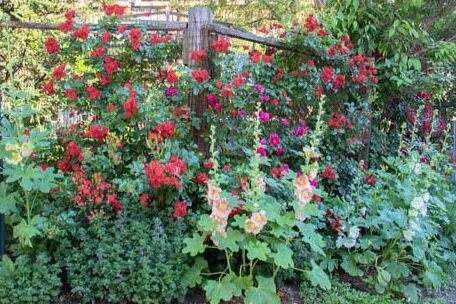The land of the Poplar Street Community Garden is a 2500 sq. ft. triangle-shaped island surrounded by streets. Its patterns of light and shade are governed by the buildings across two of the streets, the elevated highway along the third, and four tall canopy trees.
The ground slopes in two directions. The soil is a rubbly fill that’s been amended over many years to become rich with life and safe enough, as tests reveal, to work with and to grow consumables.
The only water source, other than direct precipitation, is the NYC DEP hydrant across the street.
Our ‘Little House’ is the centerpiece of the Garden. The structure today is an enlarged and further furbished version of a children’s playhouse built by their mother and brought to the Garden for storage use after the children outgrew it.
The Garden’s tool storage shed and three-bin compost system were, like the new ‘Little House,’ built by members. The Garden has two sitting areas for small gatherings and several strategically placed benches.
As much of the Garden’s space as possible is devoted to planting. The varying light and soil conditions make for variety in the planted areas, each of unique character, altogether displaying an exceptional diversity of vegetation.
Robin’s Border
Established in the 1990s by Robin Thomsen, one of the original gardeners, is a colorful display predominated by large-flowered old-fashioned perennials (peonies, lilies, etc.) to which some native plants and herbs have been added.
Sue’s Corner
This area contains some of the first herbaceous perennials planted in the garden, as put in by founding gardener Sue Eikenberry.
Naturalized Area
Under the double apple tree is where violets, asters, and other mainly native plants are allowed to self-sow amid the fallen leaves and twigs recycling back to soil. Daffodils, tulips, grape hyacinth, and others make a colorful display with the violets in early spring.
Insectary Island
This area was created when the Garden's apex area was reshaped to accommodate beehives and beekeeping, The plants were selected to appeal to pollinators, other beneficial insects, and people.
Woodland Garden
Created in 2001 around the large Yew under the Siberian Elm canopy, the Woodland Garden is a montage of low-growing shade plants, mostly natives, unusual ferns, and some medicinal herbs.
Edible Hillslope
Growing on the 'hugelkultur' mound we built in the Garden's northwest corner are bush cherries, a sour cherry tree, elderberry, and goji berry. A ground cover of herbaceous plants, many of them native and/or consumable, make a continuous display of color inside and outside the fence.
Front Corner
This area is famous for the hollyhocks planted there in the Garden's early years when few people came to this end of Brooklyn Heights. We've since planted bright red climbing roses on the fence behind them for a year-round presence and deterrent to dumping. Other perennials that can tolerate the dry conditions have been added since. Stone edging was installed in 2017 to keep parked cars from breaching the curved curb and to make space for more plants.
Personal Plots
These happily express the interests and personalities of individual members. The Garden has 15. Some are shared.










